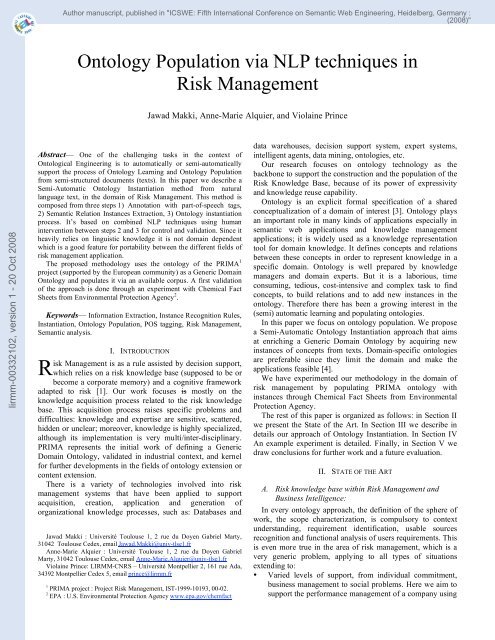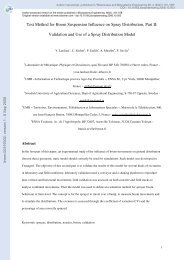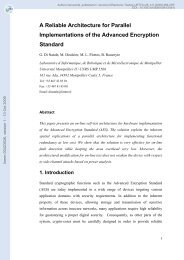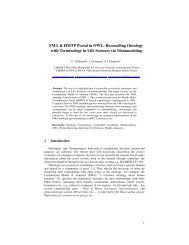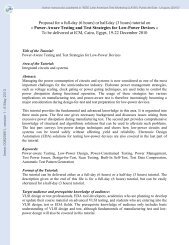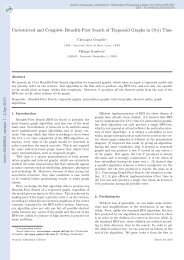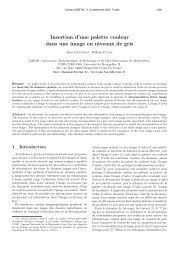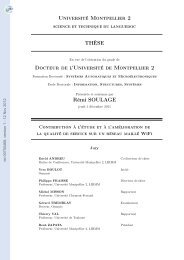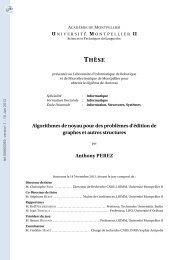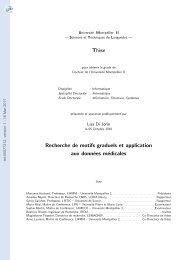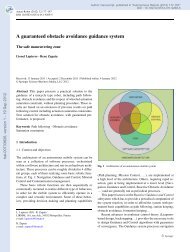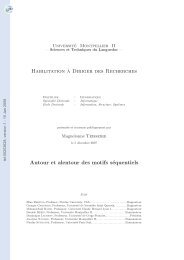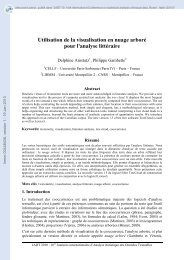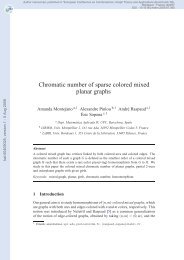Ontology Population via NLP Techniques in Risk ... - Hal-SHS
Ontology Population via NLP Techniques in Risk ... - Hal-SHS
Ontology Population via NLP Techniques in Risk ... - Hal-SHS
Create successful ePaper yourself
Turn your PDF publications into a flip-book with our unique Google optimized e-Paper software.
lirmm-00332102, version 1 - 20 Oct 2008<br />
Abstract— One of the challeng<strong>in</strong>g tasks <strong>in</strong> the context of<br />
Ontological Eng<strong>in</strong>eer<strong>in</strong>g is to automatically or semi-automatically<br />
support the process of <strong>Ontology</strong> Learn<strong>in</strong>g and <strong>Ontology</strong> <strong>Population</strong><br />
from semi-structured documents (texts). In this paper we describe a<br />
Semi-Automatic <strong>Ontology</strong> Instantiation method from natural<br />
language text, <strong>in</strong> the doma<strong>in</strong> of <strong>Risk</strong> Management. This method is<br />
composed from three steps 1) Annotation with part-of-speech tags,<br />
2) Semantic Relation Instances Extraction, 3) <strong>Ontology</strong> <strong>in</strong>stantiation<br />
process. It’s based on comb<strong>in</strong>ed <strong>NLP</strong> techniques us<strong>in</strong>g human<br />
<strong>in</strong>tervention between steps 2 and 3 for control and validation. S<strong>in</strong>ce it<br />
heavily relies on l<strong>in</strong>guistic knowledge it is not doma<strong>in</strong> dependent<br />
which is a good feature for portability between the different fields of<br />
risk management application.<br />
The proposed methodology uses the ontology of the PRIMA 1<br />
project (supported by the European community) as a Generic Doma<strong>in</strong><br />
<strong>Ontology</strong> and populates it <strong>via</strong> an available corpus. A first validation<br />
of the approach is done through an experiment with Chemical Fact<br />
Sheets from Environmental Protection Agency 2 .<br />
Keywords— Information Extraction, Instance Recognition Rules,<br />
Instantiation, <strong>Ontology</strong> <strong>Population</strong>, POS tagg<strong>in</strong>g, <strong>Risk</strong> Management,<br />
Semantic analysis.<br />
R<br />
Author manuscript, published <strong>in</strong> "ICSWE: Fifth International Conference on Semantic Web Eng<strong>in</strong>eer<strong>in</strong>g, Heidelberg, Germany :<br />
(2008)"<br />
<strong>Ontology</strong> <strong>Population</strong> <strong>via</strong> <strong>NLP</strong> techniques <strong>in</strong><br />
<strong>Risk</strong> Management<br />
I. INTRODUCTION<br />
isk Management is as a rule assisted by decision support,<br />
which relies on a risk knowledge base (supposed to be or<br />
become a corporate memory) and a cognitive framework<br />
adapted to risk [1]. Our work focuses is mostly on the<br />
knowledge acquisition process related to the risk knowledge<br />
base. This acquisition process raises specific problems and<br />
difficulties: knowledge and expertise are sensitive, scattered,<br />
hidden or unclear; moreover, knowledge is highly specialized,<br />
although its implementation is very multi/<strong>in</strong>ter-discipl<strong>in</strong>ary.<br />
PRIMA represents the <strong>in</strong>itial work of def<strong>in</strong><strong>in</strong>g a Generic<br />
Doma<strong>in</strong> <strong>Ontology</strong>, validated <strong>in</strong> <strong>in</strong>dustrial context, and kernel<br />
for further developments <strong>in</strong> the fields of ontology extension or<br />
content extension.<br />
There is a variety of technologies <strong>in</strong>volved <strong>in</strong>to risk<br />
management systems that have been applied to support<br />
acquisition, creation, application and generation of<br />
organizational knowledge processes, such as: Databases and<br />
Jawad Makki : Université Toulouse 1, 2 rue du Doyen Gabriel Marty,<br />
31042 Toulouse Cedex, email Jawad.Makki@univ-tlse1.fr<br />
Anne-Marie Alquier : Université Toulouse 1, 2 rue du Doyen Gabriel<br />
Marty, 31042 Toulouse Cedex, email Anne-Marie.Alquier@univ-tlse1.fr<br />
Viola<strong>in</strong>e Pr<strong>in</strong>ce: LIRMM-CNRS – Université Montpellier 2, 161 rue Ada,<br />
34392 Montpellier Cedex 5, email pr<strong>in</strong>ce@lirmm.fr<br />
1 PRIMA project : Project <strong>Risk</strong> Management, IST-1999-10193, 00-02.<br />
2 EPA : U.S. Environmental Protection Agency www.epa.gov/chemfact<br />
Jawad Makki, Anne-Marie Alquier, and Viola<strong>in</strong>e Pr<strong>in</strong>ce<br />
data warehouses, decision support system, expert systems,<br />
<strong>in</strong>telligent agents, data m<strong>in</strong><strong>in</strong>g, ontologies, etc.<br />
Our research focuses on ontology technology as the<br />
backbone to support the construction and the population of the<br />
<strong>Risk</strong> Knowledge Base, because of its power of expressivity<br />
and knowledge reuse capability.<br />
<strong>Ontology</strong> is an explicit formal specification of a shared<br />
conceptualization of a doma<strong>in</strong> of <strong>in</strong>terest [3]. <strong>Ontology</strong> plays<br />
an important role <strong>in</strong> many k<strong>in</strong>ds of applications especially <strong>in</strong><br />
semantic web applications and knowledge management<br />
applications; it is widely used as a knowledge representation<br />
tool for doma<strong>in</strong> knowledge. It def<strong>in</strong>es concepts and relations<br />
between these concepts <strong>in</strong> order to represent knowledge <strong>in</strong> a<br />
specific doma<strong>in</strong>. <strong>Ontology</strong> is well prepared by knowledge<br />
managers and doma<strong>in</strong> experts. But it is a laborious, time<br />
consum<strong>in</strong>g, tedious, cost-<strong>in</strong>tensive and complex task to f<strong>in</strong>d<br />
concepts, to build relations and to add new <strong>in</strong>stances <strong>in</strong> the<br />
ontology. Therefore there has been a grow<strong>in</strong>g <strong>in</strong>terest <strong>in</strong> the<br />
(semi) automatic learn<strong>in</strong>g and populat<strong>in</strong>g ontologies.<br />
In this paper we focus on ontology population. We propose<br />
a Semi-Automatic <strong>Ontology</strong> Instantiation approach that aims<br />
at enrich<strong>in</strong>g a Generic Doma<strong>in</strong> <strong>Ontology</strong> by acquir<strong>in</strong>g new<br />
<strong>in</strong>stances of concepts from texts. Doma<strong>in</strong>-specific ontologies<br />
are preferable s<strong>in</strong>ce they limit the doma<strong>in</strong> and make the<br />
applications feasible [4].<br />
We have experimented our methodology <strong>in</strong> the doma<strong>in</strong> of<br />
risk management by populat<strong>in</strong>g PRIMA ontology with<br />
<strong>in</strong>stances through Chemical Fact Sheets from Environmental<br />
Protection Agency.<br />
The rest of this paper is organized as follows: <strong>in</strong> Section II<br />
we present the State of the Art. In Section III we describe <strong>in</strong><br />
details our approach of <strong>Ontology</strong> Instantiation. In Section IV<br />
An example experiment is detailed. F<strong>in</strong>ally, <strong>in</strong> Section V we<br />
draw conclusions for further work and a future evaluation.<br />
II. STATE OF THE ART<br />
A. <strong>Risk</strong> knowledge base with<strong>in</strong> <strong>Risk</strong> Management and<br />
Bus<strong>in</strong>ess Intelligence:<br />
In every ontology approach, the def<strong>in</strong>ition of the sphere of<br />
work, the scope characterization, is compulsory to context<br />
understand<strong>in</strong>g, requirement identification, usable sources<br />
recognition and functional analysis of users requirements. This<br />
is even more true <strong>in</strong> the area of risk management, which is a<br />
very generic problem, apply<strong>in</strong>g to all types of situations<br />
extend<strong>in</strong>g to:<br />
• Varied levels of support, from <strong>in</strong>dividual commitment,<br />
bus<strong>in</strong>ess management to social problems. Here we aim to<br />
support the performance management of a company us<strong>in</strong>g
lirmm-00332102, version 1 - 20 Oct 2008<br />
risk, called management by risk. The general idea is that<br />
most bus<strong>in</strong>ess decisions are based on risk-tak<strong>in</strong>g - <strong>in</strong> the<br />
sense of opportunities as well as dangers.<br />
• Every type of risk. For example, to consider whether the<br />
materials used <strong>in</strong> a new product have hazardous impacts<br />
of are environmentally friendly, many sources should be<br />
consulted, many of them be<strong>in</strong>g outside the company. Here<br />
we focus on a specific type of risk.<br />
A risk knowledge base would capture as much knowledge<br />
as possible, capitaliz<strong>in</strong>g on all sources potentially useful,<br />
external or <strong>in</strong>ternal.<br />
Internally, a risk knowledge base capitalizes the design,<br />
development, certification, operation and lessons learnt from<br />
the past.<br />
But external knowledge is more useful is the field of<br />
strategic decision mak<strong>in</strong>g [2] and Bus<strong>in</strong>ess Intelligence.<br />
Help<strong>in</strong>g strategic decision makers is enabl<strong>in</strong>g them to operate<br />
more efficiently various data sources to get a better<br />
understand<strong>in</strong>g of their organization and competitive<br />
environment.<br />
It is then necessary to search for risk knowledge. <strong>Risk</strong><br />
Management <strong>in</strong>volves different organizations, at various<br />
levels. Knowledge is scattered <strong>in</strong> dist<strong>in</strong>ct systems and<br />
services. Extract<strong>in</strong>g relevant knowledge is not just a raw data<br />
exchange with only the correspond<strong>in</strong>g syntactic and semantic<br />
conversion issues well known <strong>in</strong> databases.<br />
But this search should not be extensive: It is impossible and<br />
it would even be harmful to <strong>in</strong>corporate any type of risk for<br />
any type of organization <strong>in</strong> a risk knowledge base. It is<br />
necessary to focus on the needs related to specific situations.<br />
Thus, knowledge acquisition cannot be fully automated; it<br />
should be rather guided by an expert, <strong>in</strong> a semi-automatic way.<br />
This expert is <strong>in</strong> charge of br<strong>in</strong>g<strong>in</strong>g together, from different<br />
sources, the doma<strong>in</strong>-specific knowledge, <strong>in</strong> order to reuse it as<br />
a basis for risk and bus<strong>in</strong>ess <strong>in</strong>telligence, and to allow<br />
afterwards the simulation support <strong>in</strong> risk management. The<br />
knowledge-acquisition expert would <strong>in</strong> fact reeng<strong>in</strong>eer riskoriented<br />
knowledge resources (databases as well as textual<br />
resources), subsequently mapp<strong>in</strong>g them to a central bone<br />
structure, an Enterprise <strong>Risk</strong> Management Mechanism.<br />
Knowledge capture <strong>in</strong> heterogeneous, <strong>in</strong>formal sources can<br />
be helped by the complex central ontology for classify<strong>in</strong>g and<br />
manag<strong>in</strong>g risks provided by PRIMA. It <strong>in</strong>cludes doma<strong>in</strong>, task,<br />
and problem-solv<strong>in</strong>g ontologies validated <strong>in</strong> several <strong>in</strong>dustrial<br />
contexts.<br />
The semi-automatic acquisition process offers the follow<strong>in</strong>g<br />
outputs:<br />
• Meta-knowledge (all the classification methods are<br />
<strong>in</strong>cluded <strong>in</strong> the knowledge base described by PRIMA).<br />
• <strong>Risk</strong> identification (the ontology is a generic host<br />
structure, but evolution is possible with appends or<br />
changes)<br />
• Detailed risk description (the cognitive framework<br />
ontology is a generic host structure, but evolution is<br />
possible with additions or changes).<br />
B. Natural Language Process<strong>in</strong>g (<strong>NLP</strong>) for Information<br />
and Knowledge Extraction<br />
Natural Language Process<strong>in</strong>g (<strong>NLP</strong>) has been largely<br />
addressed these last years as a proficient technology for text<br />
m<strong>in</strong><strong>in</strong>g <strong>in</strong> order to extract knowledge: Relevant literature is so<br />
abundant that extensively referenc<strong>in</strong>g its items is a<br />
contribution by itself. Therefore, we will stick here to papers<br />
explor<strong>in</strong>g text m<strong>in</strong><strong>in</strong>g and <strong>NLP</strong> <strong>in</strong> applications related to <strong>Risk</strong><br />
Management or to papers that <strong>in</strong>spired our model and<br />
methodology.<br />
Two types of relationships between <strong>NLP</strong> and risk<br />
management can be found: Those deal<strong>in</strong>g with risk def<strong>in</strong>ition<br />
<strong>in</strong> documents, assess<strong>in</strong>g the difficulty of probability<br />
assignment to terms (natural language items) related to risk<br />
def<strong>in</strong>ition and management [5]. Probability is re-<strong>in</strong>terpreted as<br />
a confidence value <strong>in</strong> a fuzzy logic approach to risk <strong>in</strong>ference<br />
from a natural language description [6]. These two<br />
representative works <strong>in</strong> literature tackle a crucial issue <strong>in</strong> risk<br />
ontologies extraction from texts, documents or discourse<br />
(oral/written): Term<strong>in</strong>ology is not as precisely def<strong>in</strong>ed as <strong>in</strong><br />
doma<strong>in</strong>s like medic<strong>in</strong>e or biology, risk assessment by experts<br />
<strong>in</strong> the shape of sentences does not naturally lead to an obvious<br />
formalization. Words and phrases are various, ambiguous,<br />
stylistic figures are numerous (metaphors, emphases,<br />
understatements). This drives researchers to reconsider<br />
knowledge extraction from texts as a more complex process<br />
than those described <strong>in</strong> the abundant biomedical term<strong>in</strong>ology<br />
extraction literature (e.g. [7] which deals with one of the most<br />
typical aspects of knowledge extraction, Named Entities, and<br />
their <strong>in</strong>sertion <strong>in</strong> a doma<strong>in</strong> taxonomy). Researchers such as [8]<br />
have acknowledged the gap between textual <strong>in</strong>put and<br />
knowledge as a structural pattern for a given doma<strong>in</strong>: Authors<br />
suggest annotat<strong>in</strong>g corpora <strong>in</strong> order to provide clues for an<br />
efficient knowledge extraction. Annotation means a human<br />
<strong>in</strong>tervention: It seems that more and more works recognize<br />
human judgment as an important element <strong>in</strong> the extraction<br />
process loop, a fact upon which our own approach is based (<strong>in</strong><br />
section III). This is set up to reduce the liabilities of an<br />
automatic natural language process<strong>in</strong>g extract<strong>in</strong>g knowledge<br />
<strong>in</strong> such a difficult environment.<br />
Our own approach benefits from exist<strong>in</strong>g <strong>NLP</strong> techniques <strong>in</strong><br />
order to extract knowledge from natural language text. These<br />
techniques <strong>in</strong>volve part-of-speech (POS) tagg<strong>in</strong>g <strong>in</strong> order to<br />
filter the most <strong>in</strong>terest<strong>in</strong>g categories, semantic networks to<br />
retrieve semantic relationships between phrases as concept<br />
<strong>in</strong>stances, syntactic and semantic knowledge to build concept<br />
recognition heuristics applied to texts. More precisely we used<br />
TreeTagger [9] as a POS tagger provid<strong>in</strong>g a basic syntactic<br />
structure for text. For semantic relation extraction, we relied<br />
on WordNet [10], <strong>in</strong> order to expand some specific words with<br />
related terms. This expansion <strong>in</strong>creases the chance of<br />
match<strong>in</strong>g with other semantically similar terms and decreases<br />
the problem of l<strong>in</strong>guistic variations. We also used it for the<br />
acquisition of synonyms. Last we relied on the predicative<br />
power of verbs to derive our concept recognition rules<br />
described <strong>in</strong> section III.<br />
C. <strong>Ontology</strong> population with <strong>NLP</strong> techniques<br />
<strong>Ontology</strong> population is the process of build<strong>in</strong>g the<br />
Knowledge Base. It consists of add<strong>in</strong>g new <strong>in</strong>stances of<br />
concepts and relations <strong>in</strong>to an exist<strong>in</strong>g ontology. This process<br />
usually starts after the conceptual model of ontology is built.
lirmm-00332102, version 1 - 20 Oct 2008<br />
As said <strong>in</strong> the <strong>in</strong>troduction, build<strong>in</strong>g ontology and <strong>in</strong>stantiat<strong>in</strong>g<br />
a knowledge base manually are a time-consum<strong>in</strong>g and cost<strong>in</strong>tensive<br />
process. Therefore <strong>in</strong> recent years there have been<br />
some efforts to automate it. New approaches for (semi)<br />
automatic ontology population have emerged and considerably<br />
<strong>in</strong>creased. These approaches are based on various techniques.<br />
ArtEquAKT [11]-[14] is a system that automatically extracts<br />
knowledge about artists from the Web, populates a knowledge<br />
base and uses it to generate personalized biographies.<br />
ArtEquAKT uses syntactic analysis to get the Part-Of-Speech<br />
and employs Semantic analysis to perform named entity<br />
recognition and extract b<strong>in</strong>ary relations between two<br />
<strong>in</strong>stances. ArtEquAKT applies a set of heuristics and<br />
reason<strong>in</strong>g methods <strong>in</strong> order to remove redundant <strong>in</strong>stances<br />
from the ontology.<br />
LEILA [15] is an automatic approach that can extract<br />
<strong>in</strong>stances of arbitrary given b<strong>in</strong>ary relations from natural<br />
language. LEILA uses a deep syntactic analysis and statistical<br />
techniques to learn the extraction patterns for the relation.<br />
Reference [4] describes a pattern-based method to<br />
automatically enrich a core ontology with the def<strong>in</strong>itions of a<br />
doma<strong>in</strong> glossary. Reference [4] applies a method <strong>in</strong> the<br />
doma<strong>in</strong> of cultural heritage. It is an automatic approach that<br />
extracts <strong>in</strong>stances from semi-structured corpora (Art and<br />
Architecture Thesaurus) with the help of manually developed<br />
extraction patterns.<br />
SOBA [16] is an <strong>in</strong>formation extraction system that<br />
automatically extracts <strong>in</strong>formation from heterogeneous<br />
sources (semi-structured data such as tables, unstructured text,<br />
images and image captions) and populates a knowledge base<br />
by us<strong>in</strong>g a standard rule-based <strong>in</strong>formation extraction system<br />
<strong>in</strong> order to extract named entities. These entities are converted<br />
<strong>in</strong>to semantic structures with the help of special mapp<strong>in</strong>g<br />
declarative rules. SOBA addresses the problem of entity<br />
disambiguation by perform<strong>in</strong>g simple checks dur<strong>in</strong>g <strong>in</strong>stances<br />
creation.<br />
These current approaches are based on various techniques;<br />
e.g. automated pattern recognition and extraction, statistic<br />
analysis, syntactic analysis, semantic analysis, mapp<strong>in</strong>g rules,<br />
etc. They differ from each other <strong>in</strong> some factors and have<br />
many features <strong>in</strong> common. Reference [17] def<strong>in</strong>ed the major<br />
dist<strong>in</strong>guish<strong>in</strong>g factors between ontology construction<br />
approaches. These factors are classified <strong>in</strong> the below<br />
categories “dimensions”:<br />
1) Elements learned: Concepts <strong>in</strong>stances, relations <strong>in</strong>stances.<br />
2) Start<strong>in</strong>g po<strong>in</strong>t: Doma<strong>in</strong> ontology, Unstructured Corpus,<br />
Doma<strong>in</strong> specific texts, Part-of-speech Tagger,<br />
Syntactic/Semantic analyzer, Manually eng<strong>in</strong>eered<br />
extraction patterns, additional resources (like WorldNet).<br />
3) Learn<strong>in</strong>g approach: Statistical, logical, L<strong>in</strong>guistic based,<br />
Pattern extraction, Wrapper <strong>in</strong>duction, comb<strong>in</strong>ed.<br />
4) Degree of automation: Manual, Semi-automatic (User<br />
Intervention), Cooperative, Full automatic.<br />
5) The result: List of concept <strong>in</strong>stances, List of relation<br />
<strong>in</strong>stances, Populated <strong>Ontology</strong>.<br />
6) Doma<strong>in</strong> Portability: Limited, Doma<strong>in</strong> specific, Fairly<br />
portable.<br />
<strong>Risk</strong> management is multi doma<strong>in</strong>, multi corpora with<br />
unstructured knowledge and sometimes with scarce<br />
knowledge. Mach<strong>in</strong>e learn<strong>in</strong>g approaches can not apply, so we<br />
needed to have a portable approach. Moreover as expla<strong>in</strong>ed by<br />
[8] sole automatic approaches may mis<strong>in</strong>terpret texts<br />
fragments which would be frequent as well as risky especially<br />
<strong>in</strong> the risk management doma<strong>in</strong>. Last stick<strong>in</strong>g with only one<br />
calculation method (symbolic, statistical) would deprive the<br />
system of the benefits of the other. Therefore, we have<br />
developed an appropriate method meant to be portable, semiautomatic<br />
and mix<strong>in</strong>g several techniques. It is detailed <strong>in</strong> next<br />
section.<br />
III. OUR APPROACH<br />
Our approach of ontology population is based on comb<strong>in</strong>ed<br />
statistical, syntactic and semantic techniques. It starts with an<br />
<strong>in</strong>itial generic ontology and a corpus of unstructured<br />
documents <strong>in</strong> a given doma<strong>in</strong>, and produces a populated<br />
ontology as a result of the population process. The ma<strong>in</strong> steps<br />
of our approach are the follow<strong>in</strong>g:<br />
A. Annotation with part-of-speech tags<br />
B. Semantic Relation Instances Extraction<br />
C. <strong>Ontology</strong> Instantiation process<br />
Fig. 1 Outl<strong>in</strong>e of the method<br />
There is a loop between step B and C <strong>in</strong> which human<br />
<strong>in</strong>teraction adjusts automatically extracted <strong>in</strong>formation and<br />
knowledge. The outl<strong>in</strong>e of the method is summarized <strong>in</strong> Fig. 1<br />
and the three steps are detailed hereafter.<br />
A. Annotation with part-of-speech tags<br />
The corpus (i.e. any set of texts about risk considered as the<br />
source for knowledge extraction) is processed with<br />
TreeTagger. TreeTagger annotates texts with POS and lemma<br />
<strong>in</strong>formation. As a result, this step produced for each word wi <strong>in</strong><br />
the corpus, a str<strong>in</strong>g of POS tag or a syntactic category posi<br />
(e.g. NN for nouns, VB for verbs, JJ for adjective, etc…).<br />
These tags will be used as a filter to extract the frequent verbs
lirmm-00332102, version 1 - 20 Oct 2008<br />
<strong>in</strong> next steps; it plays an important role also <strong>in</strong> the syntactic<br />
analysis.<br />
Below is a sample output from TreeTagger for this sentence<br />
"Prolonged dermal exposure to acetaldehyde can cause<br />
erythema and burns <strong>in</strong> humans":<br />
--------------- TreeTagger output -----------<br />
Prolonged JJ prolonged<br />
Dermal JJ dermal<br />
exposure NN exposure<br />
to TO to<br />
acetaldehyde NN acetaldehyde<br />
can MD can<br />
cause VV cause<br />
erythema NN erythema<br />
and CC and<br />
burns NNS burn<br />
<strong>in</strong> IN <strong>in</strong><br />
humans NNS human<br />
---------------------------------------------<br />
B. Semantic Relation Extraction / Semantic Relation<br />
Instances Extraction<br />
A semantic relation between two concepts may be<br />
expressed by a verb <strong>in</strong> natural language texts. Verbs represent<br />
an action or a relation between entities (concepts) <strong>in</strong><br />
sentences. As a result, this step aims at generat<strong>in</strong>g semantic<br />
relation <strong>in</strong>stances between concepts by extract<strong>in</strong>g all frequent<br />
verbs from the POS annotated corpus <strong>in</strong> the previous step.<br />
These verbs are assumed to be associated with exist<strong>in</strong>g<br />
relations between two concepts from the ontology, which can<br />
be valuable for populat<strong>in</strong>g the generic doma<strong>in</strong> ontology<br />
provided.<br />
Let Rab be a semantic relation between two concepts Ca and<br />
Cb of the ontology (CaRabCb). The idea is to construct from the<br />
annotated corpus, a list of verbs LVab associated to Rab where<br />
each verb can l<strong>in</strong>k the two concepts Ca and Cb. this list will be<br />
validated by a doma<strong>in</strong> expert.<br />
The list of verbs LVab associated to Rab is built by : 1)<br />
synonyms of Rab generated by the lexical resource WordNet,<br />
2) frequent verbs extracted from the annotated corpus (simple<br />
frequency count<strong>in</strong>g) 3) Human <strong>in</strong>terference by a knowledge<br />
manager or a doma<strong>in</strong> expert where his role consists <strong>in</strong><br />
validat<strong>in</strong>g the candidate set of verbs associated to Rab.<br />
In brief, this step of the method takes as an <strong>in</strong>put the POS<br />
annotated corpus and the generic ontology and produces for<br />
each semantic relation Rab between two concepts Ca et Cb of<br />
the ontology, a list of verbs LVab associated to Rab where each<br />
vi of LVab, vi can semantically connect Ca and Cb.<br />
LVab ={v1,v2,… vn} where ∀ vi ∈ LVab ∃ CaviCb<br />
Example: For Ca = « Cause », Cb = « <strong>Risk</strong> » and Rab=<br />
« provoke » the list of verbs LVab associated to Rab is the<br />
follow<strong>in</strong>g:<br />
LVab = {provoke, evoke, cause, explode, result, fire …}<br />
C. <strong>Ontology</strong> Instantiation process<br />
From the list of verbs LVab semi automatically extracted<br />
from the corpus and for each verb Vab of LVab, this step aims<br />
at identify<strong>in</strong>g and extract<strong>in</strong>g all triplets<br />
(segmenti,Vab,segmentj) from the set of sentences of the<br />
annotated corpus.<br />
A triplet (segmenti,Vab,segmentj) is extracted from a<br />
sentence S that conta<strong>in</strong>s a verb Vab of LVab. S is composed<br />
from a set of words wi like S= w1…wi Vab wj…wn. segmenti <strong>in</strong><br />
triplet represents w1…wi (i.e. the words left of the verb) and<br />
segmentj represents wj…wn. (i.e. the words right of the verb).<br />
At a second phase, each extracted triplet is proposed to a<br />
syntactic structure recognition procedure; this procedure is<br />
based on a set of predef<strong>in</strong>ed Instances Recognition Rules. To<br />
<strong>in</strong>itiate the ontology population process, these rules have been<br />
created manually by test<strong>in</strong>g (we contemplate to automate this<br />
process <strong>in</strong> a further step with learn<strong>in</strong>g algorithms such as<br />
association rules if they prove to be numerous or if those we<br />
built up don’t cover the problem). Rules can recognize a<br />
certa<strong>in</strong> amount of l<strong>in</strong>ear words configurations. They are able<br />
to identify and generate an <strong>in</strong>stance triplet (Instance_of_Ca,<br />
Instance_of_Rab, Instance_of_Cb) from the extracted triplet<br />
(segmenti,Vab,segmentj).<br />
However, these Instances Recognition Rules can be<br />
expanded with time through the addition of new rules <strong>in</strong> order<br />
to enhance the performance and the accuracy of the<br />
knowledge extraction method.<br />
As a result, this procedure generates Instance triplets that<br />
have the form of (Instancea,Vab, Instanceb) where Instancea is<br />
an <strong>in</strong>stance of concept Ca, Instanceb is an <strong>in</strong>stance of concept<br />
Cb and Vab <strong>in</strong> an <strong>in</strong>stance of relation Rab that connect Instancea<br />
and Instanceb.<br />
We dist<strong>in</strong>guish <strong>in</strong> Table I some of the Instances Recognition<br />
Rules:<br />
TABLE I<br />
INSTANCES RECOGNITION RULES<br />
associated <strong>in</strong>stances<br />
Rule l<strong>in</strong>ear words configurations<br />
triplets<br />
(Instancea,Vab, Instanceb)<br />
R1 w1…wi Vab wj…wk (w1…wi,Vab,wj…wk)<br />
R2<br />
R3<br />
R4<br />
R5<br />
R6<br />
R7<br />
w1…wi DT wj…wk Vab wl…wm<br />
where DT = that<br />
w1…wi,wj…wk,MD Vab wl…wm<br />
where MD = can<br />
w1…wi NN1 wj…wk Vab WRB<br />
VV wl…wm<br />
where WRB = when<br />
and NN1 (first noun)<br />
w1…wi Vab wj…wk CC wl…wm<br />
where CC = and<br />
w1…wi CC wj…wk Vab wl…wm<br />
where CC = or<br />
w1…wi VBZ/VBP Vab IN wj…wk<br />
where pos(Vab) = VVN<br />
and IN = by<br />
VBZ = is ; VBP = are<br />
(wj…wk,Vab,wl…wm)<br />
(w1…wi,Vab,wl…wm)<br />
(NN1 VV wl…wm,Vab,<br />
NN1 getNoun(Vab))<br />
2 triplets :<br />
(w1…wi,Vab,wj…wk)<br />
(w1…wi,Vab,wl…wm)<br />
2 triplets :<br />
(w1…wi,Vab,wl…wm)<br />
(wj…wk,Vab,wl…wm)<br />
(wj…wk,Vab,w1…wi)<br />
The produced Instances triplets will be validated by a<br />
doma<strong>in</strong> expert. Hav<strong>in</strong>g the triplet <strong>in</strong> this form « word1…wordi<br />
+ Verb + wordj…wordk» facilitate the identification of<br />
<strong>in</strong>stances of concepts/relations for the generic doma<strong>in</strong><br />
ontologies by the decision maker. F<strong>in</strong>ally this validation<br />
<strong>in</strong>stantiates the ontology and f<strong>in</strong>ishes the population process.
lirmm-00332102, version 1 - 20 Oct 2008<br />
IV. EXPERIMENTS<br />
In this section, we describe the application of our method<br />
for an example experiment <strong>in</strong> the doma<strong>in</strong> of risk management.<br />
In this experiment we use the ontology of PRIMA (the risk<br />
analysis reason<strong>in</strong>g model def<strong>in</strong>ed <strong>in</strong> PRIMA) as a generic<br />
ontology, and a corpus consists of 20 Chemical Fact Sheets (<strong>in</strong><br />
English) provided by the Environmental Protection Agency.<br />
Fig. 2 Part of the Generic <strong>Ontology</strong> of PRIMA<br />
The ontology of PRIMA conta<strong>in</strong>s a set of concepts<br />
describ<strong>in</strong>g risk and its <strong>in</strong>sertion <strong>in</strong> a technical cha<strong>in</strong> of work.<br />
<strong>Risk</strong> itself is described through 7 high level entities (or<br />
objects), the relations between those entities, plus relations<br />
with items external to risk (cost for example). Only two<br />
concepts and one relation were used for the experimentation <strong>in</strong><br />
order to populate the causal cha<strong>in</strong> of PRIMA and more<br />
specifically to <strong>in</strong>stantiate the two concepts «<strong>Risk</strong>» and<br />
«Cause» and the relation «Provoke» that connects them.<br />
Fig. 3 the causal cha<strong>in</strong> of PRIMA<br />
After apply<strong>in</strong>g a POS tagg<strong>in</strong>g on the EPA corpus, we built<br />
the list of verbs LVab associated to Relation Rab “Provoke” by<br />
gett<strong>in</strong>g the synonyms of relation “Provoke” and extract<strong>in</strong>g all<br />
the frequent verbs associated to this relation from the EPA<br />
annotated corpus. Human <strong>in</strong>tervention has validated the f<strong>in</strong>al<br />
list LVab.<br />
In a second phase, we extracted all the triplets<br />
(segmenti,Vab,segmentj) and proposed them to the syntactic<br />
structure recognition procedure. This procedure generated 150<br />
Instances triplets. 85% of these Instances triplets are evaluated<br />
as accepted <strong>in</strong>stance triplets. Table II shows some results of<br />
our method.<br />
Example 1 :<br />
For Vab = «cause» and for this entry "dermal Prolonged<br />
exposure to acetaldehyde can cause burns and erythema <strong>in</strong><br />
humans", the Instances recognition rule R5 is applied and we<br />
get two <strong>in</strong>stances triplets as follow<strong>in</strong>g:<br />
(Prolonged dermal exposure to acetaldehyde, Cause,<br />
erythema)<br />
(Prolonged dermal exposure to acetaldehyde, Cause,<br />
burns <strong>in</strong> humans)<br />
Example 2 :<br />
For Vab = «result» and for this entry "Humans Toluene<br />
<strong>in</strong>gestion result <strong>in</strong> severe central nervous system depression",<br />
the Instances recognition rule R1 is applied and we get an<br />
<strong>in</strong>stance triplet as follow<strong>in</strong>g:<br />
• (Humans Toluene <strong>in</strong>gestion, Result, severe central<br />
nervous system depression)<br />
TABLE II<br />
SOME EXPERIMENT RESULTS<br />
«Cause» «Provoke» «<strong>Risk</strong>»<br />
Exposure to large amounts of<br />
chlorobenzene<br />
Repeat exposure to<br />
nitrobenzene <strong>in</strong> air over a<br />
lifetime<br />
Prolonged dermal exposure to<br />
acetaldehyde<br />
Prolonged dermal exposure to<br />
acetaldehyde<br />
Methanol exposed to an open<br />
flame<br />
cause<br />
Humans Toluene <strong>in</strong>gestion result<br />
Exposure to moderate<br />
amounts of chlorobenzene <strong>in</strong><br />
air<br />
Adverse nervous system<br />
effects<br />
Cause cancer <strong>in</strong> animals<br />
Cause erythema<br />
Cause burns <strong>in</strong> humans<br />
explode Explosion<br />
Cause<br />
Nitrobenzene Cause<br />
Chlorobenzene has potential Produce<br />
Repeatedly breath<strong>in</strong>g large<br />
amounts of toluene<br />
severe central nervous<br />
system depression<br />
Testicular damage <strong>in</strong><br />
animals<br />
Adverse reproductive<br />
system effects<br />
adverse reproductive effects<br />
<strong>in</strong> human males<br />
Cause permanent bra<strong>in</strong> damage<br />
…………… …………… ……………<br />
V. CONCLUSION AND FUTURE WORK<br />
In this paper, we presented an appropriate method for Semi-<br />
Automatic <strong>Ontology</strong> Instantiation from natural language text,<br />
<strong>in</strong> the doma<strong>in</strong> of <strong>Risk</strong> Management. It’s based on comb<strong>in</strong>ed<br />
<strong>NLP</strong> techniques us<strong>in</strong>g human <strong>in</strong>tervention for control and<br />
validation. First experimental results show that the approach<br />
reached 85 % of accepted Instances triplets. This percentage is<br />
satisfactory results encourag<strong>in</strong>g us to go further:<br />
In populat<strong>in</strong>g other PRIMA concepts and relations with<strong>in</strong><br />
a given doma<strong>in</strong> (here the chemical risk)<br />
In populat<strong>in</strong>g PRIMA generic ontology <strong>in</strong> other risk<br />
doma<strong>in</strong> without extensive rework<strong>in</strong>g.<br />
Semantic relation extraction is not a doma<strong>in</strong> dependent<br />
process and recognition rules are by def<strong>in</strong>ition doma<strong>in</strong><br />
<strong>in</strong>dependent (they are l<strong>in</strong>guistic knowledge).<br />
S<strong>in</strong>ce we rely so heavily on <strong>NLP</strong>, <strong>NLP</strong> limitations have a<br />
crucial impact on our method. For <strong>in</strong>stance, POS<br />
disambiguation if not provided by the tagger could hamper<br />
recognition rules results («result» and «cause» are both noun<br />
and verb). Therefore, a deeper syntactic analysis than the one<br />
provided by TreeTagger, is <strong>in</strong>vestigated (we agree with<br />
LEILA authors and their choice of a real grammatical<br />
analysis).<br />
However, our method ensures a real portability from a<br />
given doma<strong>in</strong> to another if a generic ontology exists<br />
somewhere which is the case <strong>in</strong> risk management. It is flexible
lirmm-00332102, version 1 - 20 Oct 2008<br />
(easily supports enhancement), useful for expert knowledge<br />
expression (it suggests word associations to risk experts which<br />
might give them a decision support).<br />
REFERENCES<br />
[1] Alquier A.M. & Tignol M.H., 2007. “Management de risques et<br />
<strong>in</strong>telligence économique”, Economica. ISBN : 2717852522.<br />
[2] Ansoff H.I., 1990. Implant<strong>in</strong>g Strategic Management, Practice <strong>Hal</strong>l.<br />
[3] T. Gruber. Towards pr<strong>in</strong>ciples for the design of ontologies used for<br />
knowledge shar<strong>in</strong>g. Int.J. of Human and Computer Studies, 43:907–928,<br />
1994.<br />
[4] R. Navigli and P. Velardi. Enrich<strong>in</strong>g a Formal <strong>Ontology</strong> with a<br />
Thesaurus: an Application <strong>in</strong> the Cultural Heritage Doma<strong>in</strong>. In<br />
Proceed<strong>in</strong>gs of the 2nd Workshop on <strong>Ontology</strong> Learn<strong>in</strong>g and<br />
<strong>Population</strong>: Bridg<strong>in</strong>g the Gap between Text and Knowledge – OLP<br />
2006, pp. 1 – 9, Sydney, Australia, July 2006<br />
[5] Hillson, D. 2005 “Describ<strong>in</strong>g probability: The limitations of natural<br />
language.”Proceed<strong>in</strong>gs of EMEA, Ed<strong>in</strong>burgh, UK.<br />
[6] Huang, C.F.<strong>Risk</strong> 2007 “Analysis with Information Described <strong>in</strong> Natural<br />
Language “. In Computational Science, Proceed<strong>in</strong>gs of ICCS2007,<br />
Lecture Notes In Computer Science, Spr<strong>in</strong>ger Verlag.<br />
[7] Liang T, Shih PK 2005 Empirical Textual M<strong>in</strong><strong>in</strong>g to Prote<strong>in</strong> Entities<br />
Recognition from PubMed Corpus, Proceed<strong>in</strong>gs of the10th International<br />
Conference on Applications of Natural Language to Information<br />
Systems, NLDB 2005, Alicante, Spa<strong>in</strong>. Lecture Notes <strong>in</strong> Computer<br />
Science. Spr<strong>in</strong>ger Verlag. Pp 56-66.<br />
[8] Navarro B., Martínez-Barco P. and M.Palomar, 2005. “Semantic<br />
Annotation of a Natural Language Corpus for Knowledge Extraction”<br />
10th International Conference on Applications of Natural Language to<br />
Information Systems, NLDB 2005, Alicante, Spa<strong>in</strong>. Lecture Notes <strong>in</strong><br />
Computer Science. Spr<strong>in</strong>ger Verlag.<br />
[9] TreeTagger: a language <strong>in</strong>dependent part-of-speech tagger<br />
http://www.ims.uni-stuttgart.de/projekte/corplex/TreeTagger<br />
[10] Miller, G. and McDonnell, J. S. 2003. "WordNet 2.0." A Lexical<br />
Database for English, Pr<strong>in</strong>ceton University's Cognitive Science<br />
Laboratory. http://WordNet.pr<strong>in</strong>ceton.edu<br />
[11] S. Kim, H. Alani, W. <strong>Hal</strong>l, P. Lewis, D. Millard, N. Shadbolt and M.<br />
Weal. Artequakt: Generat<strong>in</strong>g Tailored Biographies from Automatically<br />
Annotated Fragments from the Web. In Proceed<strong>in</strong>gs of Workshop on<br />
Semantic Author<strong>in</strong>g, Annotation & Knowledge Markup (SAAKM’02),<br />
the 15th European Conference on Artificial Intelligence, (ECAI’02), pp.<br />
1-6, Lyon, France 2002.<br />
[12] Alani H., Sanghee K., Millard E.D., Weal J.M., Lewis P.H., <strong>Hal</strong>l W.,<br />
and Shadbolt N., Automatic Extraction of Knowledge from Web<br />
Documents, In: Proceed<strong>in</strong>g of (HLT03), 2003.<br />
[13] Alani H., Sanghee K., Millard E.D., Weal J.M., Lewis P.H., <strong>Hal</strong>l W.,<br />
and Shadbolt N., Web based Knowledge Extraction and Consolidation<br />
for Automatic <strong>Ontology</strong> Instantiation, In: Proceed<strong>in</strong>gs of the Workshop<br />
on Knowledge Markup and Semantic Annotation at the Second<br />
International Conference on Knowledge Capture (K-CAP 2003),<br />
Florida, USA, 2003.<br />
[14] H. Alani, S. Kim, D.E. Millard, M.J. Weal, W. <strong>Hal</strong>l, P.H. Lewis and<br />
N.R. Shadbolt (2003), “Automatic <strong>Ontology</strong>-Based Knowledge<br />
Extraction from Web Documents”, IEEE Intelligent Systems, 18(1), pp.<br />
14-21.<br />
[15] F.M. Suchanek, G. Ifrim and G, Weikum. LEILA: Learn<strong>in</strong>g to Extract<br />
Information by L<strong>in</strong>guistic Analysis. In Proceed<strong>in</strong>gs of the 2nd<br />
Workshop on <strong>Ontology</strong> Learn<strong>in</strong>g and <strong>Population</strong>: Bridg<strong>in</strong>g the Gap<br />
between Text and Knowledge – OLP 2006, pp. 18 – 25, Sydney,<br />
Australia, July 2006.<br />
[16] P. Buitelaar, P. Cimiano, S. Racioppa and M. Siegel (2006), “<strong>Ontology</strong>based<br />
Information Extraction with SOBA”, In Proceed<strong>in</strong>gs of the<br />
International Conference on Language Resources and Evaluation, pp.<br />
2321-2324. ELRA, May 2006.<br />
[17] M. Shamsfard, and A. Abdollahzadeh Barforoush. The state of the art <strong>in</strong><br />
ontology learn<strong>in</strong>g: a framework for comparison. The Knowledge<br />
Eng<strong>in</strong>eer<strong>in</strong>g Review (2003), 18: 293-316<br />
doi:10.1017/S0269888903000687


